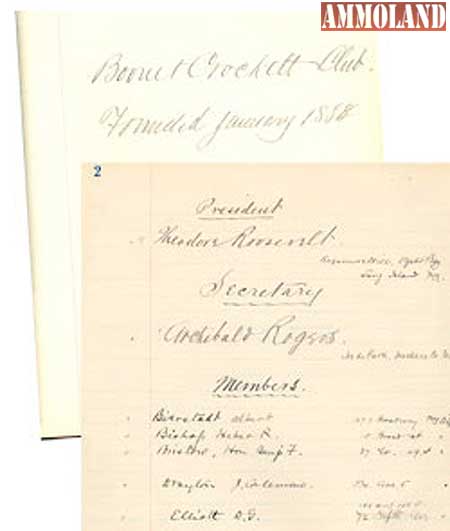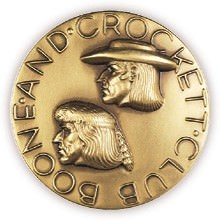

MISSOULA, Mont.--(Ammoland.com)- If you asked big game hunters about the Boone and Crockett Club, ten out of ten would respond with, “a scoring system and trophy big game records.”
This is understandable since the Club has been maintaining such records for nearly 100 years. The truth is there’s way more to this story than “heads and horns.” You may already know sportsmen like you actually established conservation in North America, but what you may not know is just how deep these roots go.
Here’s a bit of our story.
In 1887 Theodore Roosevelt and George Bird Grinnell, editor of Forest and Stream magazine, began some discussions about the careless slaughter of wildlife they’d witnessed over the years.
Grinnell stated:
“We regretted the unnecessary destruction of game animals, but we did not know what it meant, nor did we have the vision to look forward and imagine what it portended. So we discussed in a general way the preservation of game, it must be confessed–in the light of the later events–that we were talking of things we knew very little. We wanted the game preserved, but chiefly with the idea that it should be protected in order that there might still be good hunting which should last for generations.”
Roosevelt was a man of action, so in the fall of 1887 he proposed the formation of a club that would consist of big-game hunters who were true sportsmen. Grinnell embraced the idea, and in December of 1887, Roosevelt invited nine men to his home on Madison Avenue in New York City to discuss a proposal. His idea was to put together a group of influence and committed men – all sportsmen – who would actively promote five things:
- 1. Manly sport with a rifle.
- 2. Travel and exploration of unknown parts of the country.
- 3. Measures for the preservation of large game.
- 4. Observations on the habits and natural history of the wild animals.
- 5. Interchange of ideas and opinions on hunting, travel, and exploration.
Everyone approved the general concept and, with an expanded guest list, set a date for this new Club’s first meeting. Twenty men braved the bitter zero-degree cold of January 1888 to attend. Roosevelt was elected as the first president and all men in attendance became charter members. The name chosen for this group was the Boone and Crockett Club, named after the hunter-heroes of the early days of western exploration. Within a short time the Club grew to 70 regular members and 20 associates, graced by many great men like Henry Cabot Lodge and General William Tecumseh Sherman. Born from that meeting, the Boone and Crockett Club had become the first sportsman’s group ever formed to address wildlife matters on a national scale.
Unknowingly, the Club would quickly become the most influential hunter-conservationist group in North America.
During the Club’s annual meeting in 1889, members asked Grinnell and Roosevelt to edit and publish a book of articles by club members on North American big game hunting. Over the years, they would not only produce one book, but three: American Big-Game Hunting, Hunting in Many Lands, and Trail and Camp Fire. Roosevelt stated: “the big game will vanish, and only the pioneer hunters can tell about it.” Roosevelt’s statement alone illustrates the gravity of the situation at hand. He knew that this was not a time for mere words, this was a time for action.
To bring about the changes needed, Club members focused on new legislation and within a year emerged The National Zoological park in Washington D.C., and next on the agenda was saving Yellowstone Park.
Dismayed by the poor governance and lack of law enforcement of our nation’s first national park, the Club used its influence to push through Congress the Yellowstone Protection Act, which was passed in 1894. Because of the act, Yellowstone was saved from desecration by special interests that threatened Yellowstone’s natural resources and wildlife. Meanwhile, the Club joined forces with the American Forestry Association and pushed through the Forest Reserve Act which removed over 50 million acres of forests from exploitation. When Roosevelt became the 26th President of the United States he would combine these forest reserves with another 150 million acres to create our National Forest system.
Imagine what this country would be today if it weren’t for this one significant action.
While Roosevelt was in office, the Club drew more influential members and in-turn gained more influence in Washington. The list of Club accomplishments is staggering, and today’s big game populations exist because of the sheer determination of this club of individuals. Later in life, Grinnell was quoted as saying “Roosevelt’s services to science and conservation were many, but perhaps no single thing that he did for conservation had so far reaching an effect as the establishment of the Boone and Crockett Club.”
Much of what the Club accomplished was not lauded and happened behind the scenes. “Speak softy, but carry a big stick” was a phrase used by Roosevelt in his foreign policies that carried over into how the Club went about its business. Our membership includes many of the captains of conservation. Additionally, many of the hunter-conservation groups that exist today were formed by or are run by Club members. It’s hard to find any aspect of conservation history in North America that was not either established or promoted by the Club and its members.
A good question now is, what does scoring trophies and big game records have to do with conservation? The answer is everything. The Club started its record-keeping program in 1906, to document the existence of and where the different big game species lived. This was motivated by the belief at the time that these animals would soon be extinct, or reduced in population even further. Later, as conservation gained traction, big game records were used to track the recovery of big game species across their ranges. Today, such records reflect the success or failures of conservation and game management programs.
From the beginning, trophy records were used to draw more sportsmen into the conservation movement by encouraging the selective harvest of mature males, which in-turn aided population recovery. By also insisting that an ethical standard of fair chase be used in the taking of game in order to qualify for the record book, the Club was also able to elevate the status of our big game species as something to conserve and not exploit. Fair Chase became the ethical code of the sportsmen, and has remained so for over 100 years.
The Club’s accomplishments are many, and too long to list here. Please download our PDF for a more complete view of the Club’s contributions to wildlife conservation over the past 125 years.
The Boone and Crockett Club History
What is most impressive today is that amongst the noise being made by anti-hunting and animal rights groups is that the very wildlife they claim to cherish only exists today because of the efforts of sportsmen and women.
Our wildlife, their habitats, and the traditions of hunting need informed sportsmen like you to engage. One great place to start is by joining B&C. As we hope you have learned, B&C is the complete package and with your patronage we can continue to write the history books of hunter-supported conservation in North America. Please join us by becoming a Boone and Crockett Associate.
WE NEED SUPPORTERS LIKE YOU. BECOME A BOONE AND CROCKETT CLUB ASSOCIATE TODAY!
The Associates donation goes to support the Club’s ongoing efforts to ensure that, not only is wildlife and wildlife habitat given the attention it deserves, but our sporting heritage is preserved for future generations. As a Sponsor or Sportsman Associate, your generous support will receive additional benefits and be eligible for a tax deduction.
As an Associate, you will receive a Boone and Crockett window sticker and a subscription to Fair Chase magazine along with additional benefits depending on your level.
Learn more about the levels: Associate | Sponsor Associate | Sportsman Associate
